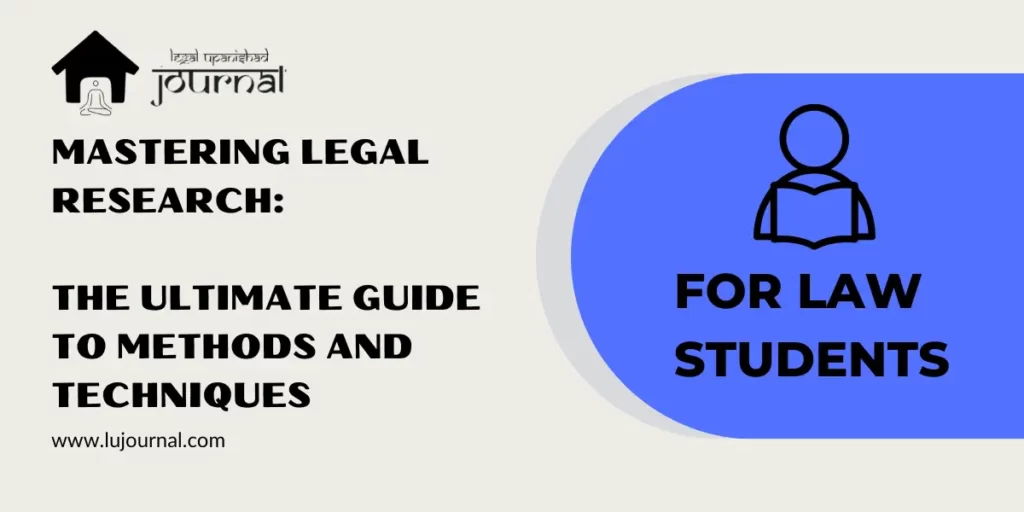This article on ‘Mastering Legal Research: The Ultimate Guide to Methods and Techniques‘ is a guide for law students. Are you willing to submit a paper for publication in a Journal?
Check the Submission Guidelines.
Table of Contents
INTRODUCTION
Effective legal research requires the use of various methods and techniques to locate and evaluate primary and secondary legal sources. This comprehensive guide aims to provide an overview of the key methods and techniques used in legal research. This comprehensive guide provides an overview of essential legal research methods and techniques.
It covers understanding the research question, primary and secondary sources, online legal research, legislative research, case law research, regulatory research, secondary source research, and the practical application of legal research. The guide aims to equip legal professionals with the necessary skills to conduct effective legal research.
WHAT IS LEGAL RESEARCH?
Legal research is an essential skill for anyone involved in the legal profession. It involves the systematic investigation and analysis of legal sources to find relevant information, understand legal principles, and support legal arguments.
LEGAL RESEARCH: METHODS AND TECHNIQUES
Understanding the Research Question
Defining the research question is the first step in legal research. It involves precisely formulating the specific legal issue or problem that needs to be addressed. This requires a clear and concise articulation of the research objective. For example, if the research question is about the legality of a certain government policy, it should be framed in a way that precisely identifies the key legal aspects involved.
Identifying key legal issues is an important aspect of understanding the research question. It requires a careful analysis of the problem at hand to determine the main legal components that need to be considered. This involves breaking down the research question into its constituent parts and identifying the specific legal concepts, doctrines, or principles that are relevant.
Breaking down complex questions is often necessary for legal research. Complex questions may involve multiple legal issues or encompass broad areas of law. To effectively address such questions, researchers need to break them down into smaller, more manageable parts. This allows for a systematic analysis of each component and ensures that all relevant legal aspects are adequately explored.
By understanding the research question, identifying key legal issues, and breaking down complex questions, researchers can lay a solid foundation for conducting comprehensive and focused legal research. These steps enable researchers to precisely define the scope of their research, identify the appropriate legal sources to consult, and ultimately, find the relevant information needed to address the research question effectively.
Primary and Secondary Sources
- Differentiating between primary and secondary legal sources: Primary sources are original legal materials, such as statutes and case law, while secondary sources are interpretations and analyses of primary sources.
- Examples of primary sources: These include legislation (laws and regulations), case law (court decisions), and regulations (administrative rules and orders).
- Examples of secondary sources: Legal encyclopedias, law journals, treatises, and commentaries are some common secondary sources that provide analysis and commentary on legal principles and cases.
Online Legal Research
- Utilizing legal research databases: Platforms like LexisNexis, Westlaw, and HeinOnline offer comprehensive collections of legal materials and tools for efficient research.
- Conducting effective keyword searches: Skillful use of keywords and search operators helps refine search queries and retrieve relevant results from vast online databases.
- Navigating online court databases and legal portals: Understanding how to navigate and access online repositories of court opinions, legal documents, and other legal resources is essential for thorough research.

Legislative Research
Accessing statutes and codes:
- Learning how to find and interpret statutes and codes is fundamental in legal research.
- Statutes are laws enacted by legislative bodies, such as Congress or state legislatures.
- Codes compile and organize statutes within specific areas of law for easy reference.
- Researchers must understand how to access and navigate statutes and codes to comprehend the legal frameworks governing a particular subject.
Understanding legislative history:
- Exploring legislative history involves delving into the process and intent behind the creation of a specific law.
- Researchers examine legislative records, including committee reports, hearings, and floor debates, to understand the rationale behind the law.
- This analysis helps interpret the law and provides context for its application in legal arguments and case analysis.
Tracking pending legislation:
- Staying updated on proposed bills and tracking their progress through the legislative process is crucial for monitoring legal developments.
- Researchers can access legislative websites or specialized platforms to follow the status of bills, amendments, and committee actions.
- Monitoring pending legislation allows legal professionals to anticipate potential changes in the law and adapt their strategies accordingly.
Legislative research is essential for understanding the statutory framework, interpreting laws, and staying informed about legislative changes. Accessing statutes and codes enables researchers to navigate legal frameworks effectively while understanding legislative history provides insights into legislative intent. Additionally, tracking pending legislation allows researchers to monitor ongoing legal developments and anticipate potential impacts on their cases or areas of interest.
Case Law Research
- Locating and analyzing judicial opinions: Knowing how to find and evaluate relevant court decisions is key to understanding legal precedents and applying them to specific cases.
- Using citators for case validation and research: Citators like Shepard’s or KeyCite provides information about the subsequent treatment and validity of a case, aiding researchers in assessing its authority.
- Reading and understanding case citations: Case citations follow specific formats and conventions and understanding them helps in locating and referencing cases accurately.
Regulatory Research
- Finding and interpreting administrative regulations: Researchers need to locate and interpret regulations issued by administrative agencies, as they often have the force of law.
- Researching agency decisions and guidance: Exploring agency decisions, opinions, and guidance documents provides insights into how regulations are interpreted and applied.
- Accessing administrative registers and federal registers: Administrative and federal registers publish proposed rules, final rules, and other regulatory announcements, which are important sources for researchers.
Secondary Source Research
- Consulting legal encyclopedias and treatises: Legal encyclopedias provide comprehensive overviews of legal topics, while treatises offer in-depth analysis of specific areas of law.
- Reviewing law reviews and legal journals: Law reviews and legal journals contain scholarly articles and commentary on legal issues, offering insights and analysis from experts.
- Exploring legal research guides and annotations: Research guides and annotations provide valuable guidance, summaries, and cross-references to relevant legal sources, aiding researchers in their exploration.
LEGAL RESEARCH: 3 SIMPLE STEPS
- Developing a research strategy and plan: Planning the research process, including setting objectives, selecting appropriate sources, and establishing a timeline, improves efficiency and effectiveness.
- Organizing and documenting research findings: Creating a systematic method for organizing and keeping track of research findings ensures that relevant information is easily accessible and properly cited.
- Applying research results to legal analysis and argumentation: Ultimately, the goal of legal research is to support legal analysis and form strong arguments, so effectively applying research findings is essential for successful legal practice.
CONCLUSION
Legal research is a fundamental skill for legal professionals, enabling them to navigate the vast and ever-evolving body of legal knowledge. By employing a range of methods and techniques, such as understanding the research question, using primary and secondary sources, conducting online research, and exploring legislative, case law, and regulatory materials, researchers can effectively gather and analyze legal information.
It is crucial to develop a systematic approach to legal research, staying abreast of the latest developments in legal research methods and tools. With the guidance provided in this comprehensive guide, researchers can enhance their legal research skills and become more proficient in their legal practice.
REFERENCES
- “How to do legal research in 3 steps”, Thomson Reuters, 10 November 2020, available at: https://legal.thomsonreuters.com/en/insights/articles/basics-of-legal-research-steps-to-follow (last visited on July 9, 2023).
- “Legal Research Methodology: Types And Approaches of Legal Research”, iEduNote, available at: https://www.iedunote.com/legal-research-methodology-types-approaches (last visited on July 9, 2023).
- Ifeoma Peters, “Legal Research Methods And Methodology” DNL Legal & Style, 2 December 2022, available at: https://dnllegalandstyle.com/2022/legal-research-methods-and-methodology/ (last visited on July 9, 2023)



